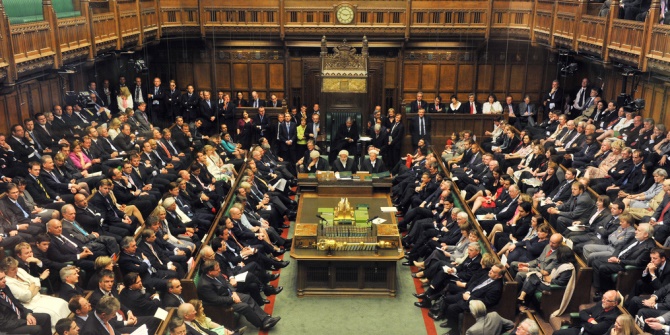
 Carl Cullinane and Laura Bruce explain how and why universities should step up the use of contextual admissions in order to meaningfully achieve fair access to leading higher education institutions.
Carl Cullinane and Laura Bruce explain how and why universities should step up the use of contextual admissions in order to meaningfully achieve fair access to leading higher education institutions.
The problem of unequal access to university is one of the most high-profile issues in British education. It is also a stubborn one. Despite substantial media attention and investment in outreach programmes, the gap in access between young people from less well-off home, and their more advantaged counterparts is wide. It is particularly acute at the most prestigious universities, where the most advantaged fifth of 18 years olds are 15 times more likely to attend than the least advantaged fifth.
Figure 1. Participation rates at high tariff universities by level of advantage (Multiple Equality Measure), England.
 Source: UCAS.
Source: UCAS.
However, while much of the media focus is frequently on the problem, it is less on concrete solutions. The University of Cambridge have recently responded to increasing pressure by reserving 100 ‘second chance’ places for disadvantaged applicants who just missed out. But if we really want to move the dial on access, we need more holistic and systematic solutions.
It is well established that applicants to university do not arrive at the point of application on an equal footing. Many have faced substantial social barriers and obstacles throughout their life – from their home background, to the school they attended, to the neighbourhood they grew up in. There are many ways in which these circumstances can affect the chances of going to university, but one of the most significant is through their impact on achievement at school.
The UK’s university admissions process is built on the school examination system. But school achievement is inevitably shaped by obstacles faced both inside and outside the school gates. This means that the true potential of a young person is frequently not reflected in their A-level results. We know that the university you attend impacts on your future earning potential, and so university admissions are a key lever for increasing social mobility. While universities cannot be expected to compensate for the effects of 18 years of inequality, they can adjust their admissions processes to take into account the context in which A-level results are achieved. This process is referred to as contextual (or contextualised) admissions. For those applying to university from a disadvantaged home background, or who grew up in a deprived area or school, their grades can be taken in context by receiving a reduced grade offer, at a grade or two below the standard for their course, or by getting a ‘second look’ if they just miss out on a place.
Contextual admissions is a growing practice among universities, but as yet, we haven’t seen a step-change in the access gaps. There are three particular issues we think are preventing contextual admissions from delivering on fairer university access: the quality of contextual indicators, transparency and consistency in offers, and greater ambition in grade reductions.
Transparency
Transparency and consistency are key, because if young people aren’t made fully aware of where and how they may benefit from a contextual offer, they may never apply, thinking a course or university is out of their reach. Universities in Scotland have made significant progress on the transparency front, with many offering contextual lookup tools which allow the applicant to check whether they would be entitled to a contextual offer, and at what level that offer may be. In England, UCL’s Access scheme is a recent example of more consistent and transparent communication of contextualisation to young people. Transparency is also important for making sure the process is clear and fair for all applicants.
Contextual indicators
Improving the quality of indicators and flags used in contextualisation is also important. Research conducted for Sutton Trust has shown that many indicators used by universities to flag widening participation candidates are based on the school or locality of a candidate. While these provide important context, they can often be misleading as to the individual circumstances of the applicant. There should be greater use of individual-level measures in contextualisation, such as eligibility for Free School Meals. The Department for Education, who holds this data, should look at providing this in a secure way, with the applicant’s consent, directly to universities through the UCAS application platform.
This research also showed that universities are using participation in outreach programmes in different ways for contextual offers. While some universities use participation in any outreach programme as a qualifying indicator for a contextual offer, many only accept participation in their own programme, and some don’t take it into account at all. This unnecessarily limits the options of outreach participants. While there is a question of assuring quality of provision across institutions, there are already great examples across the sector where universities collaborate on contextual offers for outreach participants, including the Sutton Trust’s Pathways to Law programme and Realising Opportunities.
University league tables and reduced grade offers
There has been slow progress in the ambition and extent of contextual offers. While many of those concerned with widening participation agree that greater use of contextual admissions is the way forward, there remain structural barriers to progress. One of those is the university league table industry. All the main university rankings include the A-level results of students on entry. This is counter-intuitive and results in profoundly negative incentives to universities. School league tables in recent years have a deliberate move to focus on the progress made on the progress made during a pupil’s time in a school, and not merely reward schools for taking in high-attaining kids in the first place.
The potential negative impact on a university’s ranking of admitting some students on lower grades acts as a strong brake on more ambitious contextual admissions. Use of A-level results of students before they have even entered university is a deeply flawed measure of quality, and this needs to change. Unlike school league tables, university rankings are produced by private organisations, rather than government, but this does not make them any less in need of reform.
The Office for Students’ commitment to contextual admissions and ambitious targets for the university sector are welcome. But as we see strides being made in the corporate sector, with the development of tools such as Rare’s contextual recruitment system and organisations such as Hogan Lovells and Linklaters investing in contextual recruitment, it is time to step up the use of contextual admissions to meaningfully move the dial on fair access to our country’s leading higher education institutions.
___________
 Carl Cullinane is Acting Head of Research and Policy, Sutton Trust.
Carl Cullinane is Acting Head of Research and Policy, Sutton Trust.
 Laura Bruce is Head of Programmes and Partnerships, Sutton Trust.
Laura Bruce is Head of Programmes and Partnerships, Sutton Trust.
All articles posted on this blog give the views of the author(s), and not the position of LSE British Politics and Policy, nor of the London School of Economics and Political Science. Featured image credit: Pixabay (Public Domain).







